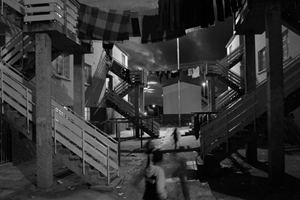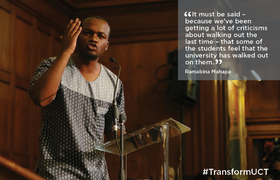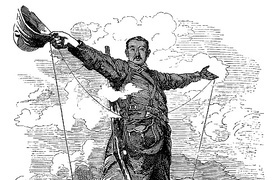Gangsters versus police: an uneven battleground
23 September 2013With Staggie's parole under scrutiny, role of police in spotlight

When Rashied Staggie's release from prison was set down for late September this year, the inevitable happened: violence flared up on his old stomping ground of Manenberg in the months leading up to that day, schools were closed as a means of protection, and non-government organisations brought their activities to a halt.
And, it is anticipated, the political underworld of gangsterism in Cape Town will shift once again whether the release comes to pass or not.
Staggie could be given day parole, in which case he will be 'free' during the day but will have to return to prison or a halfway house in the evening. He could be placed on full parole in March next year provided he doesn't commit a crime before then. He has served 10 years of the 15-year sentence he received on charges of robbery, rape, housebreaking and theft, as well as the illegal possession of firearms and ammunition.
But the fate of the Hard Livings leader is just one flashpoint in a decades-long scourge that has shaped life on the Cape Flats in myriad ways. Irvin Kinnes, a UCT PhD student researching the policing of gangs in the Cape, says "there is no finality on the number of gang members", and suggests "that new empirical research must be conducted" to determine the number of gangs and the extent of gang membership. Presently, it's estimated that between 80 000 and 100 000 people belong to approximately 120 gangs. Gang members are believed to comprise about 5% of the total population of the Western Cape, and criminologists estimate that up to 60% of serious violent crime in the Cape Peninsula is gang-related, while the police attribute approximately 70% of total crime in the province to gang activity.
Kinnes reports that from 1994 to 2006 the police launched many operations against gangs; but, he says, these have been largely ineffective. He argues that their ineffectiveness can be attributed to three main issues: firstly, gang crime is not recorded as such, and as a result there is no scientific, statistical picture of gang-related crime. Secondly, gangs have been able to rapidly reinvent themselves as organised crime bodies; and thirdly, gangs have decentralised over a number of years, and this has translated into a tighter, more cohesive structure.
Police officers' collusion with gang members is another problem that bedevils their policing, according to criminologist Liza Grobler. Their involvement could range from a refusal to act against gangsters operating drug dens and shebeens in the areas in which they live, to tipping off gang leaders about impending police raids. In her book Crossing the Line, Grobler quotes a gang boss estimating that at least thirty out of 100 police officers are in collusion with his gang.
Tony Roshan Samara, author of Cape Town After Apartheid, does not believe that increased or better policing will solve the gang problem.
"The continued strength of gangs is not a reflection of lax policing and an inefficient, under-resourced criminal justice system, but is the legacy of a half-century of State neglect and underdevelopment in the majority of the city's community. Gangs have occupied prominent places in the local economy, filling gaps created by the State," he concludes.
With the recent spate of gang violence in Manenberg the Democratic Alliance has again asked for the army to be sent in to restore law and order. Kinnes, supported in this sentiment by Samara, does not believe this to be the solution to the problem. "In order to effectively address gangs, any strategy should and must deal with the creation of legitimate opportunities for young people to access the formal and informal economy without having to resort to the illegitimate economy that gangs and drugs offer," he concludes.
Where it all started
The oldest gangs in South Africa are the prison gangs, which have a history going back to the early 1900s. Street gangs are believed to have started in District Six, with the Globe gang being the most documented and best-known of these gangs. The Globe gang members were the sons of shopkeepers and craftsmen in District Six. According to Don Pinnock, who in 1982 (under the auspices of UCT's Centre of Criminology) undertook one of the first academic investigations into street gangs, they started out as a vigilante group protecting their families' business interests. The emergence of gangsterism on the Cape Flats is attributed to three factors: forced removals as a result of the Group Areas Act; the resultant breakdown of the extended family unit; and unemployment.
Pinnock classified the gangs on the Cape Flats according to their structure, distinguishing between corner kids (playgroups formed on the streets), defence gangs (such as the Hard Livings and Americans), reform gangs (which originated in reformatories), mafias (families engaging in illegal activities) and syndicates (associations to secure the supply of drugs).
Samara refers to the forced removal of non-white communities in the 1960s and 1970s as a "catalyst for gang growth". He argues that during the 1980s "the problems associated with gangsterism were deepened through – government negligence, as drugs and gang violence were not seen as a white problem".
According to the National Institute for Crime Prevention and the Rehabilitation of Offenders (NICRO), gangs get their income mostly from "drug-dealing, prostitution, liquor distribution, housebreaking and theft".
Consolidation of the gangs' power
After the transition to democracy in the 1990s, big gangs like the Hard Livings and the Americans became more organised. Gang expert Kinnes states that these gangs had the monopoly on drug distribution, but not supply. "It was inevitable that they had to become the natural partners of foreign syndicates with better resources to bring drugs into the country," says Kinnes, referring to this period as the time in which the gangs were coming of age. The emergence of vigilante groups like PAGAD (People Against Gangsterism And Drugs) saw the police focus shifting to PAGAD instead of remaining on the gangs. PAGAD's execution of gang leaders and attempts to curb gang activities also backfired.
"The PAGAD actions succeeded only in uniting gang leaders and drug dealers," says Kinnes, thus consolidating the power of the gangs in their respective territories.
Story by Abigail Calata. Photographer Brenton Geach.
 This work is licensed under a Creative Commons Attribution-NoDerivatives 4.0 International License.
This work is licensed under a Creative Commons Attribution-NoDerivatives 4.0 International License.
Please view the republishing articles page for more information.









